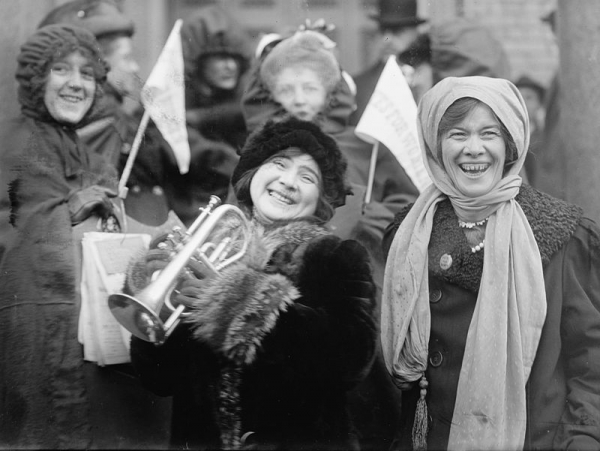Jerusalem: A Hymn To Women's Suffrage

Jeremy Dibble marks International Womens Day, and the centenary of Hubert Parry's setting of 'Jerusalem', with a discussion of the famous choral song and its links to the Womens' Suffrage Movement.
10 March 2016 marks the centenary of the completion of Hubert Parry's immutable setting of William Blake's words and arguably the English nation's favourite patriotic song. In 1927, with the centenary of the death of William Blake, there were calls for 'Jerusalem' to become an English national anthem, such was its widespread popularity, and since then its appeal has not dimmed, its message of exultant idealism, vision and endeavour being shared across the political spectrum in churches, women's institutes, schools and patriotic ceremonies. The time of its composition also seems fitting for the forthcoming parliamentary debate about the need for an English National Anthem. 'Jersualem' seems an ideal choice. It is eminently singable, the music is superbly composed for Blake's words, its mention of England characteristically modest in its celebration of universal human values, and its sense of aspiration surely makes it the ideal candidate.
Parry's choral song which, in response to a request from his old Etonian friend and now Poet Laureate, Robert Bridges, was written for the 'Fight for Right' movement. 'Fight for Right' was formed to sustain the resolve of Britain's armies and civil population during the First World War and which believed in seeing the war to a decisive victory, gainsaying those who were tempted 'to the conclusion of a premature peace'. Music was considered an important part of the meetings of 'Fight for Right'; Edward Elgar was asked to write a song, and soon after, at Bridges' suggestion, Parry set to work on his own song, a setting of William Blake's preface to his epic Milton A Poem. It should be 'suitable, simple music to Blake's stanzas,' Bridges insisted, 'music that an audience could take up and join in.' The following day it was shown to his colleague, Henry Walford Davies, at the Royal College of Music, who volunteered to have the music printed. 'I recall his unwonted happiness over it,' Davies remembered: 'One momentary act of his should perhaps be told here. He ceased to speak, and put his finger on the note D in the second stanza where the words 'O clouds unfold' break his rhythm. I do not think any word passed about it, yet he made it perfectly clear that this was the one note and one moment of the song which he treasured.' Davies, who was organist at the Temple Church, tried it out on the boys of the City of London School (who provided choristers for his choir) and these, with other choirs and choral societies in London, gathered to sing it publically for the first time at a 'Fight for Right' meeting at Queen's Hall on 28 March 1916.
'Jerusalem' instantly became popular and, because of its wide appeal, Parry added an orchestral accompaniment to the one already available in print for organ (or piano). On 17 March Parry conducted it for the ladies of the Albert Hall choir as part of a call in favour of National Service for Women. This signalled a closer relationship with the Women's Suffrage Movement of which Parry and his wife, Maude, were keen supporters. At the request of his old friend, Millicent Garrett Fawcett, the leader of the National Union of Women's Suffrage Societies, 'Jerusalem' was sung at a Suffrage Demonstration concert on 13 March 1918. 'The sound of 'Jersualem' when the audience joined in was tremendous,' Parry recalled. Fawcett suggested that it ought to become the Women Voters hymn and Parry concurred: 'I wish indeed it might become the Women Voters' hymn, as you suggest. People seem to enjoy singing it. And having the vote ought to diffuse a good deal of joy too. So they would combine happily.' Copyright was assigned to the NUWSS and when the movement was disbanded in 1928, Parry's executors reassigned it to the Women's Institutes (who had adopted it as their anthem in 1924) until the song entered the public domain in 1968.
At the same time other bodies and institutions such as public schools and the Federation of Music Competition Festivals helped to popularise the song and Elgar (who greatly admired Parry) made his own orchestration of the accompaniment in 1922, one that is nowadays more commonly used than Parry's original. It also entered the hymn book and was taken up by Malcolm Sargent in the 1950s at the Last Night of the Proms where both verses are lustily sung at the end of the evening by the enthusiastic promenaders, though Parry's original concept (evident from the published score) was for a soloist to sing the first verse so that the impact of the second verse with full choir would be especially forceful and impressive.
Dying a month before Armistice, Parry did not live to see a European peace he so longed for, nor the suffrage for women for he which passionately campaigned. Nevertheless, as a fervent proselyte of democracy, he would have been delighted at the popularity and ubiquity of his song; it is fitting in these modern times, moreover, that a piece born of democratic vision, aspiration and equality should potentially become the song of a nation.

Jeremy Dibble
Jeremy Dibble is Professor of Musicology at Durham University.
